Description
Clay is the most ancient healing remedy and hygienic substance used by humans and animals since the creation of life on Earth. In ancient texts and parchments, it is said that humans were made out of clay. In science, they have shown that life started in a mixture made of clay and water. These statements show how essential clay is for humans and most living beings on Earth.
But not all healing clays are equal. The purest and most potent clays come from the noble soil layers*(TM), which are the surface layers of very old soils. It took several centuries for the clay to concentrate and emerge to the surface, highly nourished by the roots of trees, plants and grass, in addition to a maximum exposition to natural sunlight and rainwater. This type of clay is loaded with vital energy, which provides powerful healing and rejuvenating properties.
Clay from noble soil layers are also the purest because they’re the most concentrated in clay (80-95% of clay versus 45-15% from most competition) and are extremely rich in noble minerals – the ones that are essential and bio-available (most other clays are loaded with quartz, sand and other debris). It seems that western Europe has plenty of such soils due to ancient volcanic activities (like in Auvergne, France) and ancient sea sedimentation basins (like in Brittany and Loire regions). Because clay is a powerful ABsorbing and ADsorbing substance by nature, many areas in France have been protected from human activities to preserve the purity of the soils and waters.
Be aware that many so-called “healing” clays sold today are actually shale,which is clay-rich rock found deeper in the soil where clay starts to form. These types of clay are often rejects from industrial exploitations, hence their lower price. Because they are shale, their purity is very poor (45-15% of clay content) and their safety is questionable due to their high content in heavy metals, quartz, sands and debris, as well as other polluants. Laboratory tests have shown that their ABsorbing and ADsorbing properties are much weaker in comparison to clays from noble soil layers(TM). We recommend to be careful with this common mislabeling – many “healing clays” are indeed no better than cat litter!
In order for the clay to remain potent, it is essential to minimally process it and use gentle manufacturing procedures. French clays used to be 100% sundried but in recent years, due to climate change, none of the clays coming from France can follow this ancient tradition anymore. They are exposed to the sun to be partially dried, then the drying process is completed in an oven. In order to keep the clay alive, it is important to not surpass the temperature of a natural sun exposition and use proper heating source to not contaminate the clay. Some respectable brands unfortunately use cheap combustibles to dry their clays to save on the production costs.
HOW CLAY WORKS
All clays have basically the same physical properties that vary in intensity depending on the molecular composition and structure. The molecular composition with its specific mineral content, will also give a specific color to the clay (See our different clay colors). Those characteristics will determine which clays are more interesting and safe for therapeutic applications and which are best for industrial uses. Most bentonite clays are poor-cost-effective clays used for construction (concrete) or to make cat litter! Other clays that remain toxic for therapeutic applications are great to make poteries, porcelaine, etc…
When we study clay samples under a microscope, each grain looks like layers stacked up one on to the other (like a pile of plates). This layered structure gives the plastic properties of clay and its ability to cover a surface. Layers, when hydrated, can slide one on to the others, allowing them to expend or retract themselves. This plastic ability stops as soon as the clay dries.
The mineral composition of the layers will create the specific polarity to the clay. (positive or negative charge). Basically, to make things simple and understanble, the charge of the layers themselves is negative when the charge in the space between each layer is positive.
This specific polarity, a balance between negative and positive charges, gives the binding (fixing) properties of the clay, that are also known as ABsorption andADsorption. The ABsorption property applies to liquids and is comparable to a sponge; this explains its ability in absorbing liquids and neutralizing odors. Clay can also attract molecules or organisms just like a magnet (ADsorption property). In this case, substances will stick outside of the structure. This property explains its capacity in neutralizing germs (bacteria, viruses, fungi, etc), chemicals, radiations, dead cells and other non-beneficial substances.
Depending on the size of the molecule, the attraction will be done at 3 different levels:
1) Simple ions will be captured inside the layers themselves
2) Small and flat molecules will be captured between the layers and finally
3) Macromolecules (big molecules) will stay at the periphery of the layers.
Remember that the ionic charge of clay is very fragile and is easily neutralized by any artificial treatments (additives, washing, irradition, aseptization, etc). Without this specific ionic charge, clay loses its basic properties. This the reason why you should choose a living clay (raw, virgin).
This is the ADsorbtion (fixing) properties that makes clays interesting at the therapeutic level. But as we have mentioned earlier, not all clays can be used for this purpose since, depending on their mineral composition and structure, some clays are very toxic for the body. For more safetiness, look for pharmaceutical grade and food grade clays. To benefit from the optimal properties of clay, always look for living clay – raw, non ionized, unprocessed and free of any additives,which is the quality that we provide on this website.
CLAY PROPERTIES
- Detoxifies: Thanks to its properties of ABsorption and ADsorption (see How Does Clay Work?), it neutralizes toxins, germs, impurities, chemicals, dead cells, etc and carry them out of the body.
- Disinfects: clay neutralizes pathogenic microbes, germs, bacteria, virus, fungus, etc and take them out of the body and skin. It doesn’t unbalance friendly germs indispensable for our health.
- Re-mineralizes and rejuvenates tissues: (Anti-aging properties) Exceptionally rich in bio-available essential minerals, trace elements and negative ions, clay replenishes and regenerates damaged, aging and injured tissues of the skin and the body (muscle, bone, joint, ligament, skin, liver, colon, etc). Clay is known for naturally stimulating collagen production.
- Anti-inflammatory, decongestant & sedative action: Great pain reliever! It soothes and neutralizes pain, especially for joint, muscle, back, headache, insect bites, itching, sunburns, etc.
- Re-balances tissues’ and organs’ natural functioning: Depending on the body’s or tissues’ excess or default functionning, clay will stimulate or calm down the function. It will re-balance the function to a healthy normal functioning.
- Neutralizes excess of acidity and re-balances the natural pH of different liquids, tissues and skin in the body.
- Increases cell’s oxygenation: Thanks to its free electrons and its capacity of exchanging ions. This property is a major factor to understand the regenerative properties of clay. As oxygen is the major substance in the detoxifying and alkalizing process, it makes clay an interesting remedy to add to any anti-aging and healing treatment including cancer therapy. It has been proven that cancer cells cannot develop and survive in an alkaline and oxygenated environment. More oxygenated, the body can function optimally.
- Stimulates STEM CELL production (as well as any other cell production): The first living cell on Earth appeared in a mixture made of water and clay. Without clay, life would not have been possible. Clay appears to be at the origin of Life on Earth which explains its capacity of stimulating stem cells production, which results in an increase of production of any other cells in the body such as, but not limited to, blood cells, bone cells and any tissues in the body (muscle, joints, liver, etc). This property explains the rejuvenation and anti-aging characteristics of clay.
- Brings vital energy: Only unprocessed living clay is loaded with negative ions, a vital energy-form from Mother Nature. Highly beneficial element in our modern civilizations where our vital energy is neutralized by our electrical and electronic devices, pollution, synthetic clothes, lack of natural sunlight, outside air, etc. Completely depleted from vital elements, people experience constant tiredness, extreme fatigue, low energy level, slow regeneration and rejuvenate process, slow healing, etc. A regular use of living clay is an excellent alternative to refill our batteries.
- Neutralizes excess of sebum of the skin. Absorbs liquids and grease (especially the Green Illite and Montmorillonite)
- Neutralizes odors (especially the Green Illite and Montmorillonite).
- Neutralizes radioactivity in the body – excellent after a radiotherapy or irradiation from power reactor!
All clays have the same basic properties that vary in intensity depending on their molecular structure, mineral content and quality.
OUR CLAYS’ QUALITY CHART:
- 100% living from noble soil layers
- 100% natural & pure
- Food grade – edible (ultra-ventilated clays)
- No ionization or radiation
- No preservatives, additives, artificial substances or fillers
- Manufactured in compliance with Quality Assurance Intl (ISO standards).
- Pharmaceutical grade. The content in heavy metals is in accordance with the European pharmacopoeia
- Tested by independent laboratories for maximum safety
- Cruelty-free – NO ANIMAL TESTING
- Raw material which comes exclusively from the plant and mineral kingdom.VEGAN – NO ANIMAL PRODUCTS
- Earth-friendly: Minimal use of packaging
HOW TO PREPARE CLAY
CLAY PASTE:
For external use. In a glass/wood/earth jar (NO plastic or metal containers), pour the quantity of dry clay needed (which depends on the surface that needs to be covered). Cover the dry clay with natural spring water (NO distilled, purified or tap water, which will change the ionic properties of the clay). Depending on the quantity that you prepare, leave it for 30 minutes to 4 hours (sometimes all night long) to allow the clay to absorb the water. Cover your jar with a thick cotton cloth, cellophane or any tops.
Paste consistency: When ready, the clay paste should stick to the skin and not leak. If it doesn’t stick to the skin , you need to add more water to it. If it leaks, you need to add more clay. The first time, it might take some adjustments then you will know when the paste has the right consistency just by looking at it! Some clays proportionally need less water (red, white, pink and yellow) when others need more water (Montmorillonite and Green Illite).
Application: Clay pack: Apply a thick layer of clay directly on the skin. For hairy areas or for a cleaner application, you can prepare a poultice: Use a thin natural cotton cloth. Spread a thick layer (1/8 to 1/2 inch) of clay on the cotton cloth, the size of the affected area. Fold the cotton cloth and apply it on the area. Tight it with a bandage to hold it. For both clay pack and poultice, don’t let the clay dry. Remove the pack or poultice and place a new one with fresh clay.
Preservation: You can preserve the clay paste for about 1 week at room temperature or in the fridge. Make sure that you cover the clay hermetically to prevent it from drying and absorbing odors and particles from the atmosphere. If you are on a long term treatment, you can prepare a big quantity in advance.
Temperature: Depending on the use and your body’s reaction, you can use the clay cold, warm or at room temperature. How do you know it is the right temperature? Usually you feel an immediate relief or a sense of well-being as soon as you apply the clay. If it increases the pain or you feel a discomfort, then try another temperature. Here are some general rules but you have to adapt to your experience.
Cold clay: Use cold water to prepare the clay paste. Usually used on inflamed, red and hot areas or organs. It reduces inflammation.
Warm: Never directly warm the water or the clay. Prepare the clay paste with room temperature water. Then place the jar in a container containing hot water. leave the clay until the clay becomes warm (not hot because it might burn the skin). Used to repair and regenerate areas and organs that are NOT inflamed, red and hot. On organs or tissues that are cold or depleted in energy.
Room temperature: When neither cold or warm clay improves the conditions OR when you simply don’t know which one is best OR when you are in the rush and don’t have time to warm up or cool down your clay!
In any case, a sensation of warmth should come after few minutes of application. If you still feel a cold sensation, it means that you need a warmer clay; you are yourself too cold or depleted of energy. I usually recommend that the person warms herself up by taking a hot shower or bath before a clay application.
CLAY MILK:
For internal use: In a big glass (NO plastic or metal containers) of natural spring water (NO distilled, purified or tap water which changes the ionic balance of the clay), pour 1 or 2 teaspoons of ultra-ventilated clay. Stir it up and drink it right away with the clay. You can also leave the clay all night long in the water then the next morning stir it up and drink the all mixture. Always drink the clay on a empty stomach (first thing in the morning) or 3 to 4 hours after any food intake.
Cautions: Always use an ultra-ventilated clay for your safety, it is the only clay recognized safe for internal use in Europe. The most common clays that has been clinically studied for their efficiency and safety for internal applications are the green illite, montmorillonite and white kaolin (this last one is for a short period of time only). Although some people and civilizations are using other colors with great success.
Some applications: As a clay cure for colon cleansing, liver detox and blood purification. Also good for: anemia, osteoporosis, candida infection, diarrhea, acid reflux, allergies, food poisoning and more. It increases the action of any external treatments.
Recommendations: Make sure to drink a lot of water during the day, increase the intake of fibers and avoid fats and fatty foods that will clog the clay.
Counter-indications: People with high blood pressure, kidney failure, intestinal occlusions, severe constipation, etc. Always consult your health practitioner before using any clay.

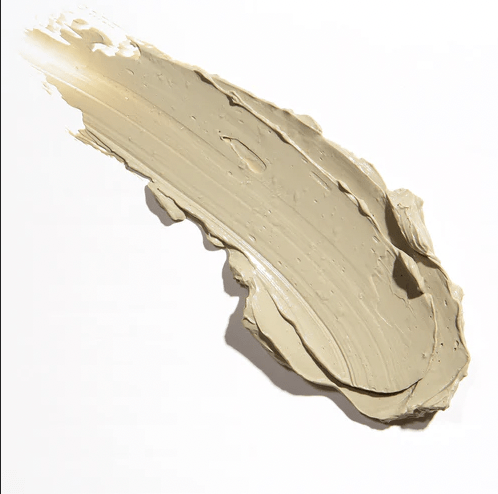
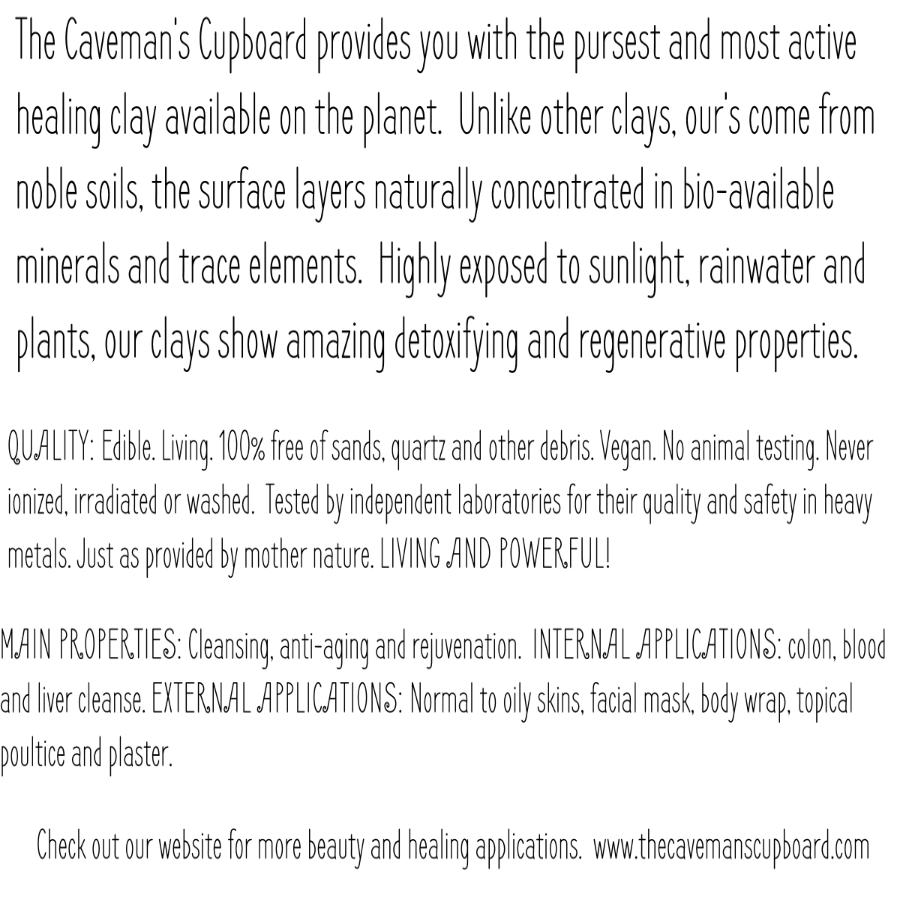
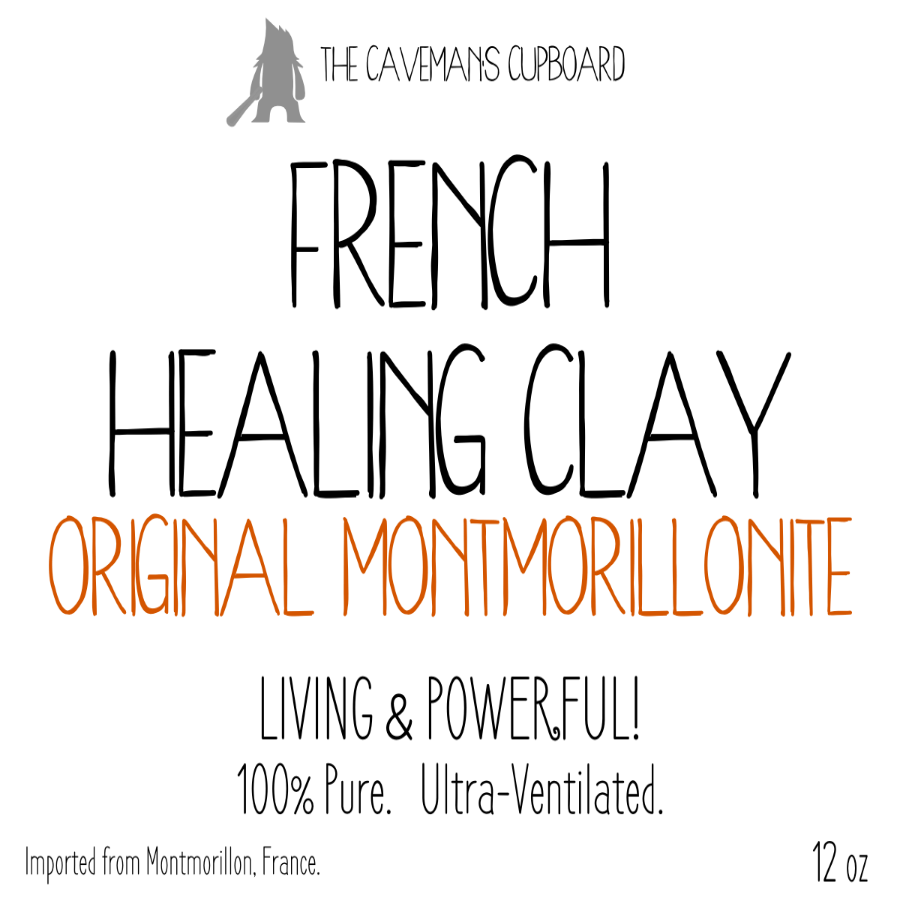
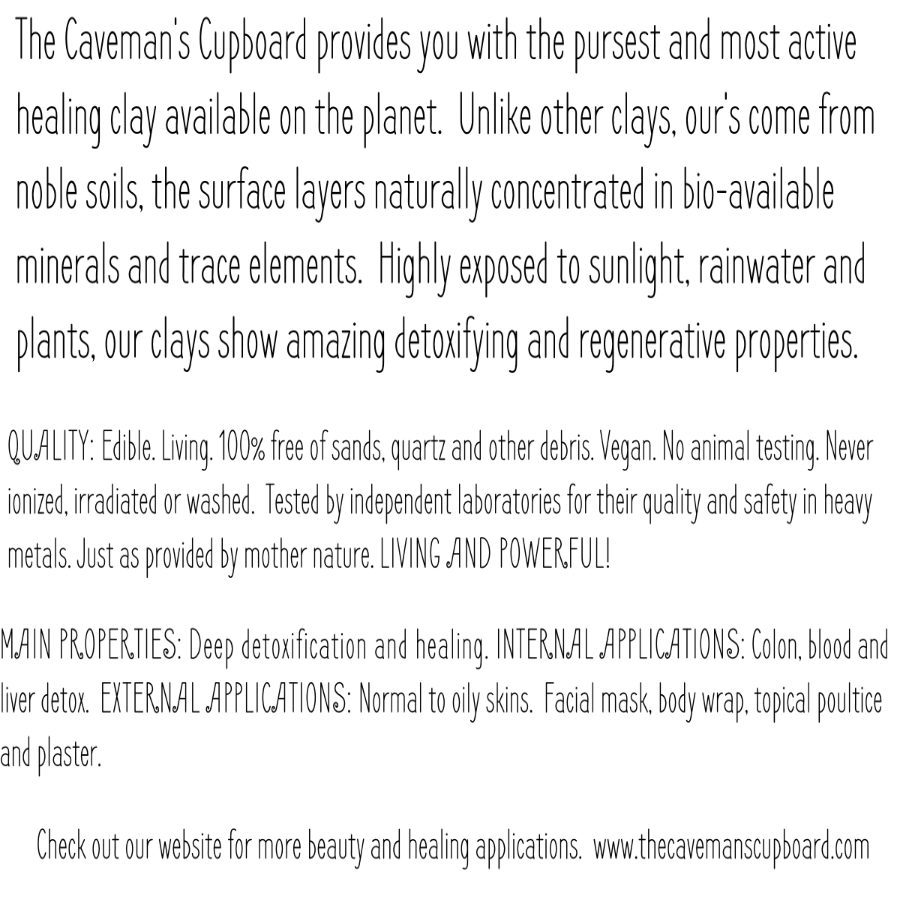
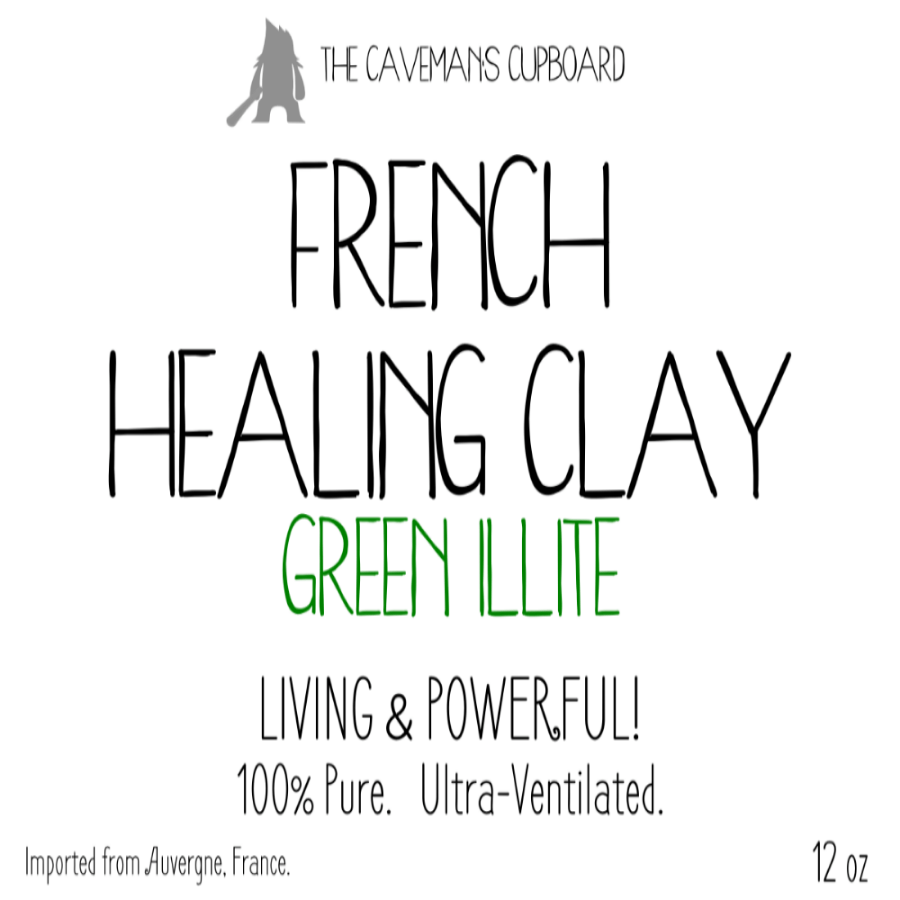
Reviews
There are no reviews yet.